|
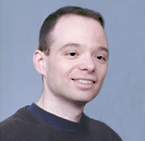
Matthew W. Kelley, Ph.D.
Chief
Developmental Neuroscience Section
NIDCD/NIH
Porter Neuroscience Research Center
35 Convent Dr.
Bethesda, Maryland 20892
Phone: (301) 435-8075
Fax: (301) 480-3001
E-mail: kelleymt@nidcd.nih.gov
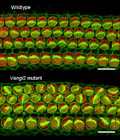 Mutations in a gene called Vangl2 lead to defects in the orientation of hair cell stereociliary bundles. Mutations in a gene called Vangl2 lead to defects in the orientation of hair cell stereociliary bundles.
View Larger Image 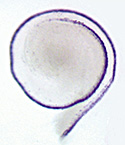 Gene expression in the organ of Corti. Gene expression in the organ of Corti.
View Larger ImageDr. Kelley received his B.A. from Cornell University and his Ph.D. from the University of Virginia. Following a post-doctoral fellowship at the University of Washington, he became an Assistant Professor in the Department of Cell Biology at Georgetown University in 1996. In 2000 he moved to the NIDCD, first as Acting Chief and then (since 2004) as Chief of the Developmental Neuroscience Section. Dr. Kelley's laboratory works on the cellular and molecular development of the mammalian cochlea.
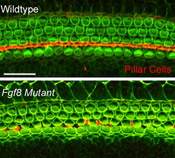 A targeted mutation in the Fgf8 gene results in a disruption in the development of pillar cells (red). A targeted mutation in the Fgf8 gene results in a disruption in the development of pillar cells (red).
Larger image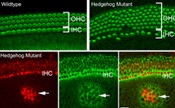 A mutation in the Hedgehog signaling pathway results in extra hair cells in the cochlea. A mutation in the Hedgehog signaling pathway results in extra hair cells in the cochlea.
Larger imageResearch Statement
The overall goals of the Developmental Neuroscience Section are to identify the molecular and cellular factors that play a role in the development of the sensory epithelium of the mammalian cochlea (the organ of Corti). The organ of Corti is comprised of at least 6 distinct cell types that are arranged in highly conserved mosaic. The generation of a specific number of each cell type and the arrangement of these cell types into a regular pattern are essential for the normal perception of sound; however, our understanding of the factors that play a role in the development of this structure is extremely limited.
Current research in the laboratory is focused on the mechanisms that control the number of cells that will develop with each distinct phenotype. Previous results have demonstrated that the number of cells that will develop as sensory hair cells is regulated through inhibitory interactions between neighboring cells. These results suggest that the possible cell fates within the cochlea may be arranged in a hierarchy and that as the number of cells that become specified to develop as a single phenotype increases, these cells then begin to produce inhibitory signals that force the remaining cells to develop with alternate fates.
A second area of interest is the mechanisms that control overall cellular pattern within the cochlea. The cellular pattern of the mammalian cochlea is arranged in a gradient such that one type of sensory cell is located on one edge of the epithelium and a second type of sensory cell is located on the opposite edge. At both edges the sensory cells are arranged in distinct rows. The factors that specify the formation of this pattern are unknown; however, preliminary results suggest that the Wnt signaling pathway may play a role in the development of this pattern.
Finally, recent work in the laboratory has begun to examine the molecular factors that regulate the development of planar polarity within the cochlea. All hair cells have a "V"-shaped stereociliary bundle located on their apical surface. In the cochlea, all stereociliary bundles are oriented such that the vertex of each "V" points in the same direction. The correct orientation of these bundles is required for normal hearing. Research in our laboratory has recently begun to identify the molecular signaling pathways that are required for the orientation of these bundles and future work will examine the specific roles of these pathways in the cochlea.
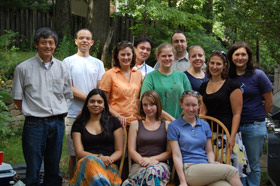 Developmental Neuroscience Section Developmental Neuroscience SectionLab Personnel
Bonnie Jacques, Pre-doctoral Fellow, 301-435-8074 (Send e-mail)
Chandrakala Puligilla, Post-doctoral Visiting Fellow, 301-435-8074 (Send e-mail)
Elizabeth Driver, Post-doctoral Visiting Fellow, 301-435-8074 (Send e-mail)
Weise Chang, Biologist, 301-435-8074 (Send e-mail)
Katherine Szarama, Pre-doctoral Fellow, 301-435-8074 (Send e-mail)
Takayuki Okano, Post-doctoral Visiting Fellow, 301-435-8074 (Send e-mail)
Helen May-Simera, Post-doctoral Visiting Fellow, 301-435-8074 (Send e-mail)
Zoe Mann, Post-doctoral Visiting Fellow, 301-435-8074 (Send e-mail)
Thomas Coate, Post-doctoral Fellow, 301-435-8074 (Send e-mail)
Selected Publications
- Driver EC, Pryor SP, Hill P, Turner J, Rüther U, Biesecker LG, Griffith AJ, Kelley MW. Hedgehog signaling regulates sensory cell formation and auditory function in mice and humans. J Neurosci. Jul 16;28(29):7350-8, 2008.
- Kelley MW. Leading Wnt down a PCP path: Cthrc1 acts as a coreceptor in the Wnt-PCP pathway. Dev Cell. Jul;15(1):7-8, 2008.
- Chen Z, Montcouquiol M, Calderon R, Jenkins NA, Copeland NG, Kelley MW, Noben-Trauth K. Jxc1/Sobp, encoding a nuclear zinc finger protein, is critical for cochlear growth, cell fate, and patterning of the organ of corti. J Neurosci. Jun 25;28(26):6633-41, 2008.
- Kelley MW. Has hair cell loss MET its match? Proc Natl Acad Sci U S A. 2007 Oct 16;104(42):16400-1. Epub Oct 9, 2007. No abstract available.
- Kelley MW. Cellular commitment and differentiation in the organ of Corti. Int J Dev Biol. 51(6-7):571-83, 2007. Review.
- Jacques BE, Montcouquiol ME, Layman EM, Lewandoski M, Kelley MW. Fgf8 induces pillar cell fate and regulates cellular patterning in the mammalian cochlea. Development. Aug;134(16):3021-9, 2007. Epub 2007 Jul 18.
- Puligilla C, Feng F, Ishikawa K, Bertuzzi S, Dabdoub A, Griffith AJ, Fritzsch B, Kelley MW. Disruption of fibroblast growth factor receptor 3 signaling results in defects in cellular differentiation, neuronal patterning, and hearing impairment. Dev Dyn. Jul;236(7):1905-17, 2007.
- Hertzano R, Dror AA, Montcouquiol M, Ahmed ZM, Ellsworth B, Camper S, Friedman TB, Kelley MW, Avraham KB. Lhx3, a LIM domain transcription factor, is regulated by Pou4f3 in the auditory but not in the vestibular system. Eur J Neurosci. Feb;25(4):999-1005, 2007.
- Kelley MW. Regulation of cell fate in the sensory epithelia of the inner ear. Nat Rev Neurosci. Nov;7(11):837-49, 2006.
- Montcouquiol M, Crenshaw EB 3rd, Kelley MW. Noncanonical Wnt signaling and neural polarity. Annual Review of Neuroscience 29:363–86, 2006.
- Montcouquiol M, Sans N, Huss D, Kach J, Dickman JD, Forge A, Rachel RA, Copeland NG, Jenkins NA, Bogani D, Murdoch J, Warchol ME, Wenthold RJ, Kelley MW. Asymmetric localization of Vangl2 and Fz3 indicate novel mechanisms for planar cell polarity in mammals. The Journal of Neuroscience 26(19):5265–75, 2006.
- Jones JM, Montcouquiol M, Dabdoub A, Woods C, Kelley MW. Inhibitors of differentiation and DNA binding (Ids) regulate Math1 and hair cell formation during the development of the organ of Corti. The Journal of Neuroscience 26(2):550–8, 2006.
- Dabdoub A, Kelley MW. Planar cell polarity and a potential role for a Wnt morphogen gradient in stereociliary bundle orientation in the mammalian inner ear. Journal of Neurobiology 64(4):446–57, 2005.
- Woods C, Montcouquiol M, Kelley MW. Math1 regulates development of the sensory epithelium in the mammalian cochlea. Nature Neuroscience 7(12):1310–8, 2004.
- Barald KF, Kelley MW. From placode to polarization: new tunes in inner ear development. Development 131(17):4119–30, 2004.
- Hertzano R, Montcouquiol M, Rashi-Elkeles S, Elkon R, Yucel R, Frankel WN, Rechavi G, Moroy T, Friedman TB, Kelley MW, Avraham KB. Transcription profiling of inner ears from Pou4f3(ddl/ddl) identifies Gfi1 as a target of the Pou4f3 deafness gene. Human Molecular Genetics 13(18):2143–53, 2004.
- McKenzie E, Krupin A, Kelley MW. Cellular growth and rearrangement during the development of the mammalian organ of Corti. Developmental Dynamics 229(4):802–12, 2004.
- Xu Q, Wang Y, Dabdoub A, Smallwood PM, Williams J, Woods C, Kelley MW, Jiang L, Tasman W, Zhang K, Nathans J. Vascular development in the retina and inner ear: control by Norrin and Frizzled-4, a high-affinity ligand-receptor pair. Cell 116(6):883–95, 2004.
- Ng L, Goodyear RJ, Woods CA, Schneider MJ, Diamond E, Richardson GP, Kelley MW, Germain DL, Galton VA, Forrest D. Hearing loss and retarded cochlear development in mice lacking type 2 iodothyronine deiodinase. Proceedings of the National Academy of Sciences of the USA 101(10):3474–9, 2004.
 Cover of Naturejournal, Cover of Naturejournal,
Volume 423: 173-176, 2003  Cover of Development journal, Cover of Development journal,
Volume 130 (11), June 2003
View Larger Image - Kelley MW. Cell adhesion molecules during inner ear and hair cell development, including notch and its ligands. Current Topics in Developmental Biology 57:321–56, 2003.
- Kelley MW, Lanford PJ, Jones I, Amma L, Ng L, Forrest D. Analysis of nuclear receptor function in the mouse auditory system. Methods in Enzymology 364:426–48, 2003.
- Montcouquiol M, Kelley MW. Planar and vertical signals control cellular differentiation and patterning in the mammalian cochlea. The Journal of Neuroscience 23(28):9469–78, 2003.
- Kelley MW. Exposing the roots of hair cell regeneration in the ear. Nature Medicine 9(10):1257–9, 2003.
- Kelley MW. Determination and commitment of mechanosensory hair cells. TheScientificWorldJournal 2:1079–94, 2002.
- Montcouquiol, M., Rachel, R.A., Lanford, P.J., Copeland, N.G., Jenkins, N.A., and Kelley, M.W. Identification of Vangl2 and Scrb1 as planar polarity genes in mammals. Nature 423:173–176, 2003.
- Daboub, A., Donohue, M.J., Brennan, A., Wolf, V., Montcouquiol, M., Sasson, D.A., Hseih, J.-C., Rubin, J.S., Salinas, P.C. and Kelley, M.W. Wnt Signaling Mediates Reorientation of Outer Hair Cell Stereociliary Bundles in the Mammalian Cochlea. Development 130:2375–2384, 2003.
- Mueller, K.L., Jacques, B.E. and Kelley, M.W. (2002) FGF signaling regulates pillar cell development in the organ of Corti. The Journal of Neuroscience 22:9368–9377.
- Griffith AJ, Szymko YM, Kaneshige M, Quinonez R, Kaneshige K, Mastroianni MA, Kelley MW, Cheng S. Knock-in mouse model for resistance to thyroid hormone (RTH): An RTH mutation in the thyroid hormone receptor beta gene disrupts cochlear morphogenesis. Journal of the Association for Research in Otolaryngology 3(3):279–288, 2002.
- Rüsch A, Ng L, Goodyear R, Oliver D, Lisoukov I, Vennström B, Richardson G, Kelley MW, Forrest D. Retardation of cochlear maturation and impaired hair cell function caused by deletion of all known thyroid hormone receptors. The Journal of Neuroscience 21:9792–9800, 2001.
- Angel Campos-Barros A, Amma LL, Wang Z, Shailam R, Kelley MW, Forrest D. Type 2 iodothyronine deiodinase expression in the cochlea preceding the onset of hearing. Proceedings of the National Academy of Sciences of the USA 97:1287–1292, 2000.
- Lanford PJ, Shailam R, Norton CR, Gridley T, Kelley MW. Expression of Math1 and HES5 in the cochleae of wildtype and Jag2 mutant mice. JARO 1:161–170, 2000.
- Zhang N, Martin GV, Kelley MW, Gridley T. A mutation in the lunatic fringe gene suppresses the effects of a Jagged2 mutation on inner hair cell development in the cochlea. Currents in Biology 10:659–662, 2000.
Top |
| |